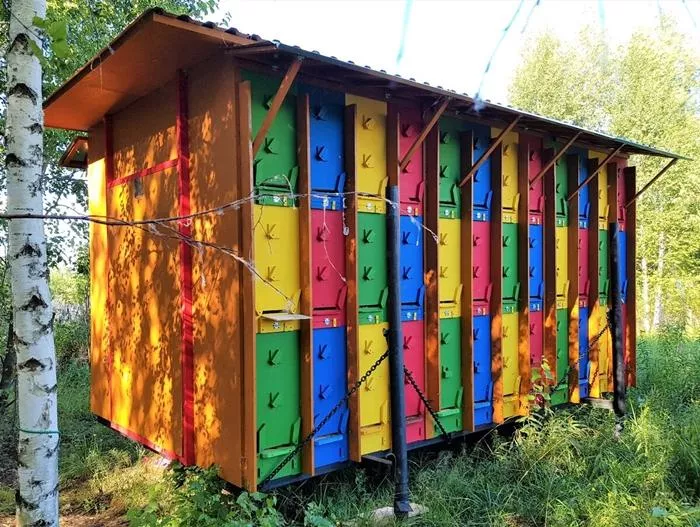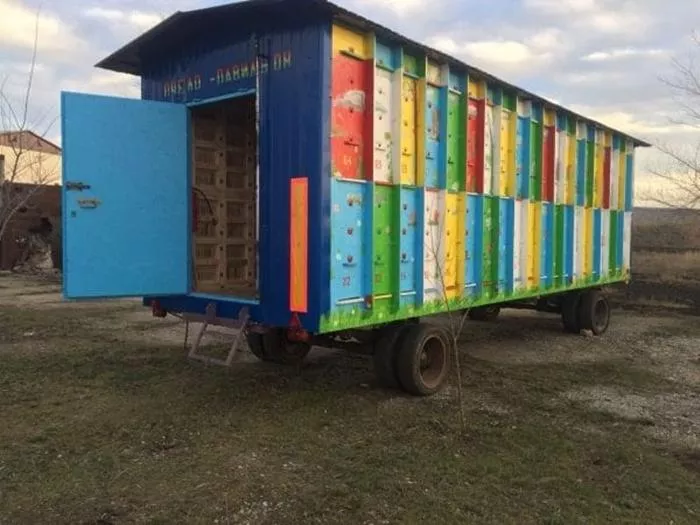Pavilion Berendey: the benefits of using in the apiary, drawings and how to do it yourself
Thanks to the comfortable keeping of bees, it is possible to significantly simplify the care of the beekeeper for insects and improve the quality of honey products. Using the Berendey pavilion, it is easy for beekeepers to arrange the spring-summer migration of bees. Advantages of the cassette type design: mobility, lightness, compactness, protection of bee colonies from freezing / getting wet.
What is this?
The cassette-type Berendey pavilion is a small mobile/stationary van with several rows of hives fixed inside. The advantage for the beekeeper is the ability to open each box separately from the others and comfortably care for a particular bee colony.
Most often, 1-4 cassette compartments are placed inside the van, in which several risers are fixed level by level. The pavilion can comfortably accommodate 16, 32, 46 bee colonies.
History of Appearance
Traditional frame hives show a number of disadvantages: they are poorly ventilated inside, inconvenient for cleaning and disinfection, accumulate moisture, are characterized by crowding of insects, bulky and difficult to transport. Thanks to the development of technology, since the middle of the twentieth century, it has become possible to assemble multi-tiered thin-walled pavilion structures. The buildings allow you to comfortably keep a different number of bee colonies all year round.
The Berendey design was developed by the Grachev family of beekeepers in order to simplify and reduce the time for caring for insects.
Advantages of the pavilion: ease of assembly and maintenance, stability, mobility and ease of transportation, maintaining a comfortable temperature regime, saving space when placing the structure.
Production Features
Manufacturers offer a wide range of Berendey pavilions, which can accommodate a different number of bee colonies. However, using the drawings, it is not difficult to assemble the structure yourself.
Required tools and materials
To make elements and assemble a full-fledged pavilion, you will need drawings, the following materials:
- plywood/wood planks 20mm thick;
- wooden beam with parameters 60x70 mm or metal pipe;
- hardboard and foam sheets;
- roofing material;
- mesh with cells 2.5x3 mm in size (metal, wood or nylon);
- nails, screws.
To assemble a bee pavilion, you will need the following tools: hammer, pliers, planer, drill / screwdriver and drills, knife, tape measure.
Assembly process
For the correct and comfortable functioning of the pavilion for bees, it is important to take into account the requirements of the drawing. You also need to follow the phased assembly sequence.
- Form a frame. To do this, supports are cut out of beams or pipes and tightly sheathed with boards. To ensure sealing and insulation, the inner sides are sheathed with layers of roofing material and hardboard.The sound insulation of the pavilion will be provided by the outer casing of the frame with foam plastic. The design assumes the presence of 5 doors, each of which provides access to two cassettes.
- Feeders are fixed on the doors, a net is fixed on the bottom of the risers to protect against ticks and parasites.
- The individual size cassette boxes are knocked together (height 140-296 mm, length 450-460 mm, width 357-360 mm). A gap of 15 mm is maintained between the boxes.
- On the front walls of the lower drawers, a notch is kept (a wide opening 20 mm high for the penetration of bees). The entrances of the upper drawers are made in the form of round holes.
- Mobile cassettes are provided with special guides and fixed handles.
- The subframe according to the size of the cassette is assembled from timber and covered with mesh.
To make it comfortable to serve the structures in the apiary, each pavilion is equipped with a mobile or folding table.
Content specifics
When caring for pavilions, they follow standard rules: in spring, bee families are carefully examined, structures for disinfection are treated with special solutions; cassettes are replaced in a timely manner, honey is regularly pumped out, the inside of the structure is kept clean, buildings are insulated with special shields for the winter.
The nuance of using the pavilions is the limited internal space, so you need to move inside carefully. In the process of work, it is important not to make noise and carefully care for insects. It is also necessary to take into account the fire hazard of buildings. Since the materials from which the cassettes are assembled are highly flammable.
Berendey pavilions are considered a progressive method of breeding and keeping bees. The simple design greatly simplifies the procedure for caring for insects and their transportation. You can purchase ready-made structures or assemble pavilions of the required parameters with your own hands.
Recommended
Hive Varre: drawings and dimensions, pluses for beekeeping, content and how to do it yourself

Beekeeper Emile Varre's beehive - a general description of the design, a little history, drawings and dimensions, rationality of use, necessary tools and materials, DIY assembly.
Alpine hive: drawings and dimensions, how to do it yourself and keeping bees

All about the Alpine hive: description, diagrams, drawings. How to make a beehive with your own hands. How to relocate bees: advice and recommendations from beekeepers.
Pavilion for bees: maintenance rules and how to do it yourself, drawings

What are pavilions for bees. What are the types, advantages and disadvantages of designs. How to make a pavilion with your own hands. How to keep bees in buildings.













